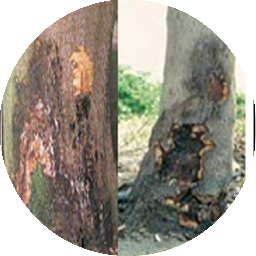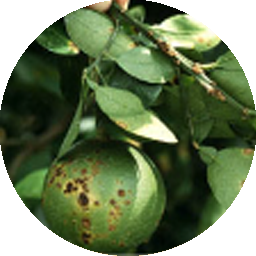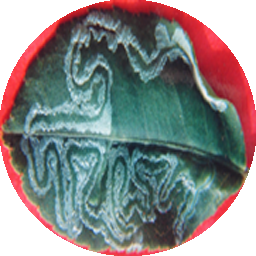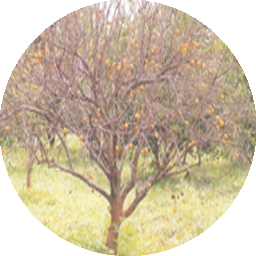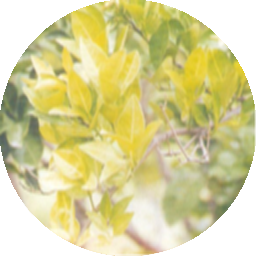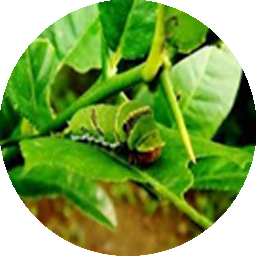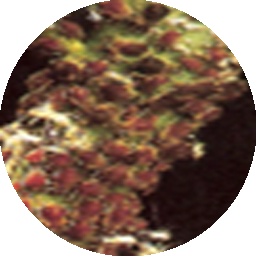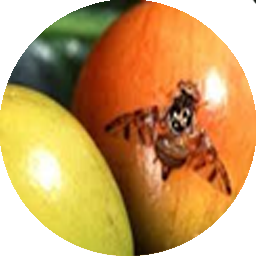Citrus Symptoms & Management
×
Symptoms:
1. Disease starts as water soaked patches on basal portions of the stem near ground level.
2.Patches turn dark staining of bark brown.
3.Infection progresses into the wood.
4.Infected bark dries, shrinks and cracks and shreds lengthwise in to vertical strips.
5.Reddish brown gum exudes from the bark of infected trunk. Gum exudation is considerable in sweet oranges, but relatively little in grapefruit.
6.Infection extends to crown roots.
7. Affected collar region is girdled and finally the infected tree dies.
8. Prior to death, the tree usually blossoms heavily and dies before the fruits mature.
Management:
Preventive measures
1. Selection of proper site with adequate drainage
2. Selection high budded grafts (30 to 45 cm or above)
3. Following Double ring method of irrigation by providing an inner ring about 45 cm around the tree trunk to prevent direct moistening of trunk
4. Avoid injuries to crown roots or base of stem during cultural operations
5.Use resistant sour orange or trifoliate orange rootstocks for propagating popular/commercial varieties
6.Painting Bordeaux paste or with ZnSO4, CuSO4, lime (5:1:4) to a height of about 60 cm above the ground level at least once a year.
Curative measures
1. Scrape/chisel out the diseased portion
2. Protect the cut surface with Bordeaux paste followed by spraying with Fosetyl-Al 0.2%
3.Soil drenching with 0.2% Metalaxyl (Metalaxyl+Mancozeb = Ridomil MZ 72)
4.Apply Trichoderma viride multiplied on neem cake
×
Symptoms:
1.Canker appears on leaves, petioles, twigs, branches, fruit stalks, fruits and thorns. When it is severe, trunk and roots are also affected
2.But the symptoms are most conspicuous on leaves, twigs and fruits.
3.On leaves minute water soaked round spots develop which enlarge slightly and turn brown, eruptive and corky
4.On acid lime and sweet orange leaves spot measure about 2 to 3 mm in diameter and are surrounded by a characteristic yellow halo
5.Due to severe infections of the leaves there may be defoliation, and severe infections of the twig and stem may cause die-back symptoms.
6. The plants also remain stunted and fruit yields are reduced considerably
7.Canker lesions on the fruit are not surrounded by yellow halo. Several lesions on fruit coalesce to form a patch. The crater-like appearance is marked on fruits than on leaves
8. The market value of the fruits is considerably reduced by the canker spots, though such infections are mostly confined to the fruit skin
Management:
1. Select healthy seedlings and grafts for planting in new areas
2. Prune out and burn all canker infected twigs before monsoon
3. Periodical spraying of Streptocycline (1 g) + Copper oxychloride (30 g) in 10 litres of water at fortnightly interval in nurseries and at fortnightly interval in orchards during rainy season
4. Use canker tolerant varieties like “Tenali selection” and “Balaji”
5. Control leaf miner when young flush is produced
×
Favourable conditions:
1. Free moisture for 20 minutes at 20-30°C and high relative humidity (>85%) favour initiation of disease
2. Infestation by citrus leaf miners (Phyllocnistis citrella)
Management:
1. Select healthy seedlings and grafts for planting in new areas
2. Prune out and burn all canker infected twigs before monsoon
3. Periodical spraying of Streptocycline (1 g) + Copper oxychloride (30 g) in 10 litres of water at fortnightly interval in nurseries and at fortnightly interval in orchards during rainy season
4. Use canker tolerant varieties like “Tenali selection” and “Balaji”
5. Control leaf miner when young flush is produced
×
Symptoms:
1. Tristeza affected trees look chlorotic and sickly in the early stages. Gradually the leaves drop and the defoliated twigs show die-back. The declining trees die gradually but sometimes apparently healthy trees die suddenly
2.Vein clearing or vein flecking (elongated translucent area) in young leaves of acid lime is visible when viewed against light (characteristic symptom)
3.Characteristic stem pittings are formed on infected trees
4.In sweet orange, the specific symptom of tristeza is honeycombing, a fine pitting of inner face of bark in the portion of trunk below the bud union. In acid lime vermiform or linear pits appear in the woody cylinder
5.Tristeza infected citrus trees on sour orange rootstocks cause phloem necrosis at the graft union
6.Diseased trees usually blossom heavily. Trees with stem pitting are stunted and set less fruits. The fruits are of smaller size and of poor quality (insipid fruits). As the fruits develop, the tree wilts partly or completely.
7. Grapefruit and acid lime are susceptible irrespective of root stock
Management:
1. Strict quarantine measures to be enforced. Use certified budwood free of CTV to prevent primary (vertical) spread of disease
2. Remove all diseased trees as and when the disease is noticed. Fresh plantings to be taken with virus free materials on tolerant rootstocks. For sweet orange and mandarin avoid susceptible root stocks
3. For Andhra Pradesh, Maharashtra and Karnataka, Rangapur lime is recommended as a root stock resistant to Tristeza. For the Punjab region, Jattikhatti, Cleopatra mandarin and sweet orange are recommended as resistant root stocks
4. For acid lime, use seedling preimmunised with mild strain of tristeza virus (Cross protection)
5.Periodic sprays of insecticides like dimethoate or methyl S demeton at 2 ml/l to reduce the secondary (horizontal) spread of the disease in the orchard
×
Symptoms:
1. Affected trees are stunted with pronounced leaf and fruit drop. Varied chlorotic patterns on leaves are noticed which are persistent and cannot be corrected by mineral nutrient sprays.
2. Reduction in leaf size is common. Many affected leaves show small circular green islands within the chlorotic areas. Heavy leaf fall occurs with the onset of summer. Often new flush may come out with leaves that are short, upright and chlorotic having green veins or with green blotches on the leaves
3. Twig die-back occurs. Some branches in a tree exhibit severe symptoms whereas others in the same tree are apparently normal
4. Fruits show reduction in size, lopsided in growth and oblique (curved) columella.
5. The rind surface exposed to sun appears yellow whereas the remaining portion remains dull green. Diseased fruits are valueless owing to small size, distortion, low in juice and soluble solids, high in acid and insipid taste
6. Seeds are poorly developed, dark coloured and aborted.
Management:
1.Select certified disease-free seedlings. Use pathogen free bud wood for propagation
2.Raise virus free plants through shoot tip grafting
3.Remove and destroy infected trees
4.Control psyllids with insecticides like dimethoate, or methyl s demeton
5.Tetracycline (500 ppm) spray though effective, requires fortnightly application and is also not advocated for human health reasons
×
Damage:
Grub bores the trunk at ground level horizontally up to the pith and then tunnels vertically and again horizontally for exit. Attacked trees gradually dry up .
Management:
1. Swabbing of tunnel either with Dichlorvos (0.1%) or Monocrotophos (0.02%) kills the grub effectively.
2. Cotton soaked petrol in tunnels and plug with mud.
×
Damage:
Newly emerged larva mines the under surface of the leaf in a zigzag way. Serpentine mines on the underside of leaf which are silvery in colour due to entrapped air are the characteristic symptoms (Fig. 32). Attacked leaves curl-up from the margins towards inner side, eventually dry up and fall down. Since new flush is attacked, growth in severely hampered. In case of twig attack in young plants ‘die-back’ also occurs (Fig. 33). Ventral leaf surface is preferred by the pest but due to high population pressure dorsal infestation is also seen. Citrus leaf miner helps in spreading mealy bug infestation and also acts as foci of citrus canker.
Management:
1. Spray NSKE 4% if infestation is moderate during new flush emergence, under heavy infestation give alternate sprays involving monocrotophos @ 1.5 ml or quinalphos 2 ml/l.
2. Prune heavily infested branches destroy them and spray should be aimed at young flush only.
3. Prasitoids such as Tetrastichus phyllocnistoides, Cirrospillus quadristriatus, Simpieses purpurea and black chalcid, Ageniaspis sp. larvae cause about 30 to 45 and even upto 80% parasitism.
×
Damage:
The pest attacks mandarin and acid lime plantations almost throughout the year but is serious during July-August. Larvae being the voracious feeder cause severe defoliation of plants.
Management:
1. Collect and destroy larvae, which look like bird dropping in the early stage.
2. The pest can be controlled by foliar spray of any of the contact or systemic insecticides viz., dimethoate @ 1.5 ml, fenitrothion 1ml, or quinallphas 2ml/l at an early larval stage.
3. Dipel (Bacillus thuringiensis Berl.) spray at 0.05% gives good control of the pest. Entomopathogens like bacterium Serratia marcesscens and fungus Fusarium sp. also kill the pest population substantially.
4. A braconid Apanteles flavipes and ichneumonid Melalophacharops sp. are the predominant larval parasitoids and a chalcid Pteromalus puparium and a inchaneumonid Holcojoppa coelopyga are the major pupal parasitoids which could be utilized for effective control of the pest biologically.
5. Release Trichogramma chilonis @ 500 adults per tree.
×
Damage:
Adults and nymphs suck the sap from tender leaves and shoots devitalizing the plants. The pest secretes copious sugary solution on which sooty mould grows (Fig.34 & 35). Brown citrus aphid, Toxoptera citricida, is responsible for vectoring citrus virus disease ‘Tristeza .
Management:
1. Spray quinalphos or dimethoate 0.05% at weekly intervals. In case of severe outbreak, spray imidacloprid 200SL@ 0.25 ml/l.
2. An inchneumonid parasitoid lipolexis scutellaris and the predators like chrysopids, coccinellids, syrphids feed on this pest.
3. Release Chilomenes sexmaculata @ 50 per plant in the absence of natural enemies.
×
Damage:
It is a serious pest of maturing mandarin fruits. The adults puncture the ripening fruits. Such fruits drop prematurely as a result of rottening due to fungal and bacterial infections introduced through punctures causing considerable fruit loss.
Management:
1. Poison baiting with 20 g malathion (W.P) + 200 g gur with some vinegar or fruit juice in 2 litres of water (two bottles containing poison bait per 25-30 trees) has been found quite effective.
2. Use light traps to collect moths.
3. Sprays of malathion or dimethoate (1ml/l) should also be given on the weeds around the orchard where the young stages of the pest survive.
4. Destroy fallen fruits by burying in the ground.
5. Clean cultivation of the orchard is must to avoid the pest development
